|
|
 |

Perhaps you’ve heard the old saying: “Just as great art arises from suffering artists, great wine stems from suffering vines.” Old sayings often prove true, but sometimes they turn out to be nonsense, so it’s wise to subject them to examination. If you want to put this one to the test, there’s no doubt that the best place to do it is in the astonishing Spanish region of Priorat.
I’d have a tough time telling you what was the best wine I've tasted in 2017, but I could tell you in an instant what were the most remarkable places I've seen, and Priorat was certainly one of them. A quick trip there in April was my fifth to Priorat. This brings to mind yet another old saying, “Seeing is believing,” which I now suspect is nonsense since I’ve seen Priorat five times...but still can’t believe it.
If you want to just how miserably a vine can suffer, I can give you a couple examples of places from which to look within Priorat.
First, have a look from anywhere near the top of the phenomenally steep L'Ermita vineyard from which Alvaro Palacios conjures the celebrated 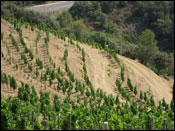 wine bearing the site's name. You'll see gnarled, windblown Garnacha vines that were planted some 75 years ago, and these vines cannot possibly be pleased with their circumstances. wine bearing the site's name. You'll see gnarled, windblown Garnacha vines that were planted some 75 years ago, and these vines cannot possibly be pleased with their circumstances.
It seems that they cling to the site only because someone went through the unbelievably arduous effort of carving terraces into the hillside and stacking the displaced slate into retaining walls. Each vine is pinned in place by a spike on a little flat spot on one of these terraces, but the overall impression lent by the place has nothing to do with flatness. You get the idea that nobody working in the vineyard gets to make more than one mistake. Any misstep would be fatal. Either you'd plummet to the bottom of a ravine or be impaled along the way by one of the stakes. Take your pick.
The soil barely deserves that name, being nothing but crumbled rock with no apparent nutrients. Not one of my five visits has provided a shred of evidence that it ever rains in Priorat, and in fact the region routinely goes for months without receiving any appreciable rain. There’s no system for irrigating the vines, which, to any layman's eye, should therefore be quite dead. But it turns out that the strata of slate have little layers of powdered clay between them, and that these retain just enough moisture to let very tenacious vines survive if they are meticulously tended.
There was one guy tending them on the day of my first visit to this vineyard eleven years ago, but I couldn't get a good look at him. He was working only 150 feet in front of me, but about 500 feet down, and he was wearing a big straw hat to avoid being scorched by the sun. Also, as he was tilling the "soil," he was trailing a mule. A tractor wouldn't have 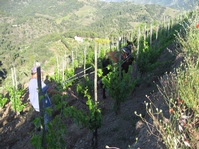 a prayer in this vineyard. I got a better look at him this year, or maybe at his successor--though I shrink from the thought of what might have happened to the guy I saw in 2006. a prayer in this vineyard. I got a better look at him this year, or maybe at his successor--though I shrink from the thought of what might have happened to the guy I saw in 2006.
After standing on a precipice in this vineyard for a few minutes, you'd get the idea behind what’s in a bottle of L’Ermita. If one were willing to endure the rigors of this sort of viticulture, there's not much doubt about what you'd yield: Very little fruit that would be exceedingly concentrated and intensely mineral in character. And you'd need to sell it for a lot of money or you'd go broke in a hurry.
A quick check on the web as I write this shows the lowest asking price for either the L’Ermita 2012 or 2013 in the USA is $1,199.99. You don’t want to know about the highest price.
A second suggestion for those wanting additional insight into Priorat’s uniqueness is take a walk through the town of Porrera before heading up to the vineyards in the heights above. The town itself is among few in the region that has maintained a population of any size after the successive ravages of phylloxera, civil war and urbanization that have racked the region during the past century. Checking in with a population of about 500, Porrera is a veritable boom town by Priorat standards, edging out wine villages like Capçanes by several dozen heads and Gratallops by a couple hundred.
Porrera is at once impressive and sad, looking somewhat hollowed out from a past period of prosperity but still formidable in its forbidding setting. On account of its fierce resistance during the Spanish Civil War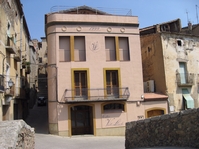 and the subsequent fascist repression of Catalonia, the town holds a reputation as one of the most rebellious places in the entire province. Catalonian secession from Spain still remains a live possibility, though the political situation vis-à-vis Madrid is now much less volatile than it was 45 years ago. However, you can still sense a sort of defiance in the place and its people. Those who have stayed to farm in the area have a certain toughness about them, and when you head up into the vineyards, you learn where it comes from. and the subsequent fascist repression of Catalonia, the town holds a reputation as one of the most rebellious places in the entire province. Catalonian secession from Spain still remains a live possibility, though the political situation vis-à-vis Madrid is now much less volatile than it was 45 years ago. However, you can still sense a sort of defiance in the place and its people. Those who have stayed to farm in the area have a certain toughness about them, and when you head up into the vineyards, you learn where it comes from.
I’ll never forget a walk (more like a climb) that I took up from Porrera during my first visit with a few friends and a host from Celler Vall Llach, an excellent producer that has been releasing renaissance Priorat wines for the past 25 years. Vall Llach draws its fruit from many trossos that it has purchased, which are small, old estate plots with very old Garnacha and Cariñena vines with 65 to 95 years of age. They buy some high-quality fruit as well, but the core of the wines stems from the efforts of those who tend Vall Llach's tortured-looking vines.
Having visited more than 1,400 wine estates around the world, I've seen some tough vineyard conditions, but I cannot understand how it is possible for a vine even to survive on the seemingly sheer face of a Priorat hillside composed entirely of crumbled rock.
One vine in particular commanded my admiration. It was clinging to a little outcropping that afforded it a toehold against the force of gravity 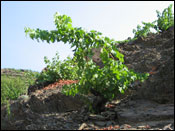 but no room to sink a root in search of water or nutrients. This vine apparently managed to survive by extending a taproot out along the exposed surface of rock for a full 15 feet before finding a crack into which it could burrow for a little sustenance. How the plant survived long enough to accomplish this feat is entirely beyond my comprehension. but no room to sink a root in search of water or nutrients. This vine apparently managed to survive by extending a taproot out along the exposed surface of rock for a full 15 feet before finding a crack into which it could burrow for a little sustenance. How the plant survived long enough to accomplish this feat is entirely beyond my comprehension.
Seeing such conditions at mid-slope from the road made me wonder what things were like at the top. Fueled by a just-consumed thermos of coffee but sorely lacking in prudence, I scrambled up the slope as best I could--which was not very well. I'd estimate the angle of the hillside at 50 degrees, and, while climbing, I found it very difficult to tell how firm the footing would prove beneath any particular step in the thoroughly decomposed slate. It was solid at one point but lethally loose within another foot. The appropriate footwear for this ascent would be some sort of cross between a rock-climbing slipper and a snowshoe, if you can imagine such a thing.
At the crest, there was nothing to be found except an assortment of vines, mostly very old but a few quite young, arrayed in no discernable pattern. There was no evidence of life on the ground aside from the vines, and I couldn't figure out whether the absence of weeds was attributable to fastidious viticulture--or good sense on the part of weeds.
Even insects were strangely absent, and though I was buzzed by a couple of birds, they seemed not to be feeding, but rather trying to figure out what the hell I was doing in such a forbidding place. of birds, they seemed not to be feeding, but rather trying to figure out what the hell I was doing in such a forbidding place.
In this environment, the survival of the old vines seemed amazing, but the ability of the young ones to establish themselves without irrigation struck me as downright miraculous. As I started to wonder what their attrition rate might be, the prospect of becoming a casualty myself sent me on my way back down through the slippery slate. This could only be accomplished by zig-zagging slowly at a very shallow angle, rather like a petrified skier who has bumbled onto a mogul run that exceeds his capabilities.
Once I had managed to escape from this vineyard, where every step could be one’s last, I wondered what those who work in it would think if they were to see the lush vines that luxuriate on the valley floor in Napa. Would they laugh? Cry? Demand a raise? Relocate?
Vines suffer in Priorat, but so too do vintners, judging by my experience. That fact helps to explain a paradox: Priorat is a place where one can make a wine to sell for $1,200 per bottle, and yet almost nobody lives there.
I think I can understand this by reflecting back on that slope above Porrera and the guy working behind the horse on the slopes of L'Ermita. 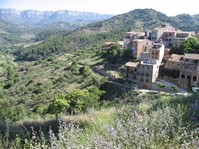 It also helps to recall that beautiful, bustling Barcelona offers lots of good jobs only 75 miles away, and that the gorgeous beaches along the Mediterranean are closer still, with plenty of nice jobs in hotels and restaurants. By contrast, the name of the town nearest to the L'Ermita vineyard, Gratallops, literally means, "where the wolves are howling," in reference to the harshness of conditions in Priorat. It is one of the most striking wine regions I've ever seen, and I strongly recommend that you see it if you can. But see it as a visitor, and be grateful that someone else will still be working there after you leave. It also helps to recall that beautiful, bustling Barcelona offers lots of good jobs only 75 miles away, and that the gorgeous beaches along the Mediterranean are closer still, with plenty of nice jobs in hotels and restaurants. By contrast, the name of the town nearest to the L'Ermita vineyard, Gratallops, literally means, "where the wolves are howling," in reference to the harshness of conditions in Priorat. It is one of the most striking wine regions I've ever seen, and I strongly recommend that you see it if you can. But see it as a visitor, and be grateful that someone else will still be working there after you leave.
|
 |
|